Starting group workouts with anxiety doesn't have to be overwhelming. You'll benefit from increased endorphins and social connections while building a supportive fitness community. Begin with beginner-friendly, low-impact activities like gentle yoga, water aerobics, or walking groups that match your comfort level. Bring a friend to early sessions, start with smaller classes, or try virtual workouts to ease into the experience. Remember, most participants focus on their own exercise, not on judging others. You can gradually increase your involvement as your confidence grows. The journey to anxiety-friendly fitness starts with choosing the right group activity for you.
Why Group Exercise Helps Anxiety
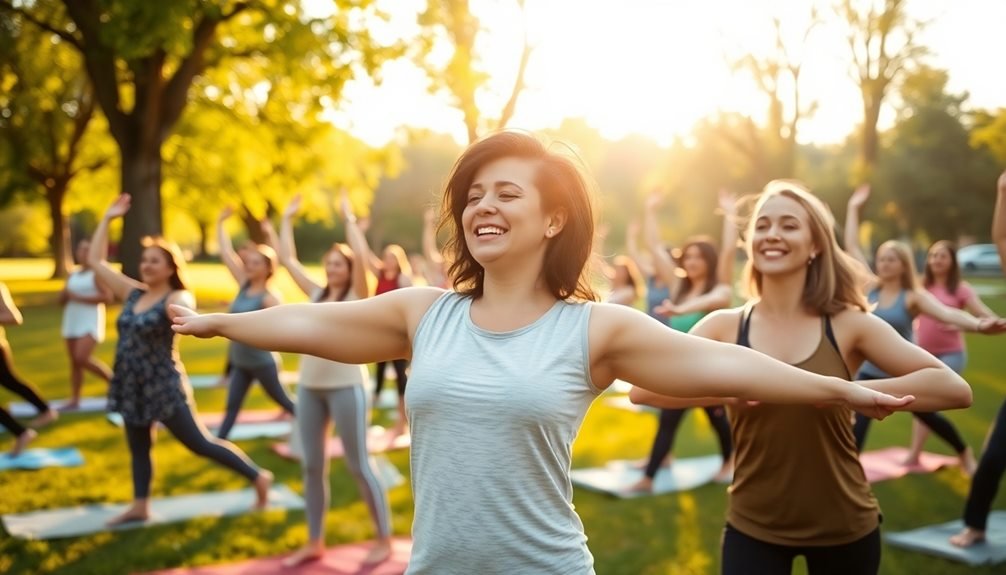
Regular group exercise offers powerful relief from anxiety through multiple psychological and social mechanisms. When you work out with others, your brain releases higher levels of endorphins and serotonin compared to solo exercise, creating a natural mood boost. The social connection you experience during group workouts also reduces feelings of isolation that often accompany anxiety.
Group exercise provides built-in accountability and structure, which helps combat the avoidance behaviors common with anxiety disorders. You're more likely to show up and complete your workout when others expect your presence. The shared experience creates a sense of community, where you'll find support from people who understand your fitness journey.
The group setting also helps normalize breathing patterns and physical sensations that might trigger anxiety. When you see others managing their exertion and recovery, it reinforces that these bodily responses are normal and manageable.
Additionally, focusing on synchronized movements with your group redirects attention away from anxious thoughts, creating a form of moving meditation. The predictable routine of group classes provides a safe environment where you can challenge yourself while feeling supported.
Choosing Your First Group Class
When selecting your first group fitness class, prioritize activities that match both your comfort level and current fitness abilities. Look for beginner-friendly classes that emphasize basic movements and offer clear instruction. Gentle yoga, low-impact aerobics, and introductory strength training classes often provide ideal starting points.
Consider the class size and timing carefully. Smaller classes typically offer more personal attention and feel less overwhelming, while off-peak hours tend to be less crowded. You'll want to check if the instructor welcomes newcomers and provides modifications for different fitness levels.
Location and accessibility matter too. Choose a facility that's convenient to reach and has a welcoming atmosphere. Many gyms offer free trial classes, so you can experience the environment before committing.
Don't overlook the class description and duration. A 45-minute class might be more manageable than a 90-minute session when you're just starting.
Read reviews or ask for recommendations from friends who've taken similar classes. If possible, arrive early to meet the instructor and familiarize yourself with the space, which can greatly reduce first-day anxiety.
Best Low-Impact Group Activities
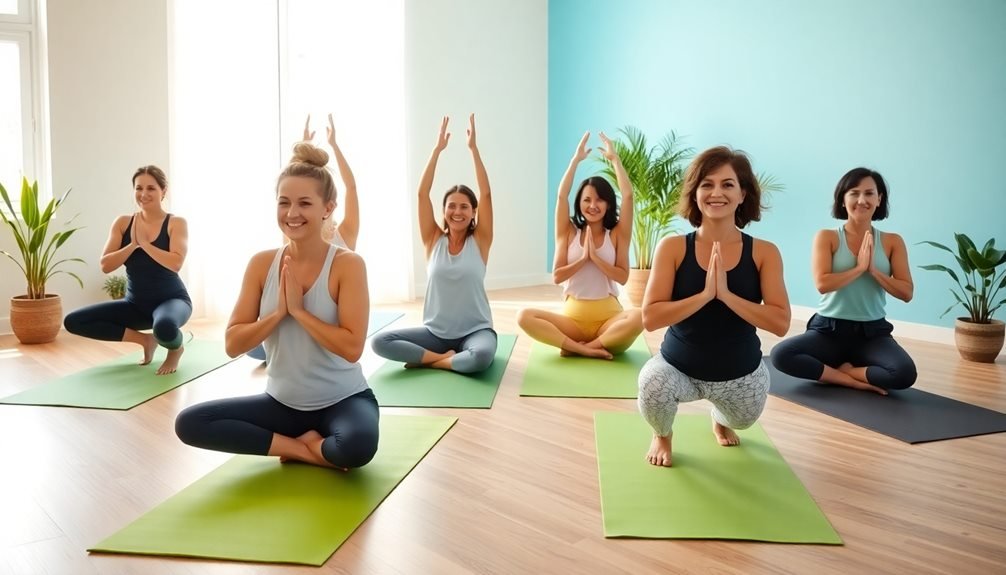
After finding your ideal class setting, you'll want to explore specific activities that keep stress levels low while maximizing physical benefits. The key is choosing exercises that don't overwhelm your system or trigger anxiety symptoms.
| Activity | Benefits |
|---|---|
| Gentle Yoga | Improves flexibility, breathing control, mindfulness |
| Water Aerobics | Reduces joint impact, provides natural resistance |
| Tai Chi | Enhances balance, promotes calm, builds strength |
| Walking Groups | Combines social support with cardiovascular health |
These low-impact activities offer significant advantages for anxiety management. You'll find that gentle yoga classes help regulate your nervous system through controlled breathing and deliberate movement. Water aerobics provides a supportive environment where you can work out vigorously without jarring motions. Tai Chi's flowing movements create a moving meditation that calms your mind while strengthening your body. Walking groups combine the benefits of light cardio with social connection, making them perfect for beginners who want to ease into group exercise.
Remember to start with shorter sessions and gradually increase duration as your comfort level grows. You'll likely discover that these activities become valuable tools in your anxiety management toolkit.
Building Social Confidence Through Movement
Many people find that combining physical movement with social interaction creates a natural pathway to greater confidence. When you're focused on learning new movements or following an instructor's cues, you'll naturally spend less time worrying about social interactions. This shared experience helps break down social barriers organically.
Start by choosing group activities that match your comfort level. Walking groups or gentle yoga classes offer low-pressure environments where you can ease into social situations while moving your body. As you become more comfortable, you'll notice that shared physical activities create natural conversation starters and common ground with others.
You can build momentum by setting small, achievable goals. Perhaps start by making eye contact and smiling at one person during class, then progress to brief conversations about the workout. Many participants find that discussing the shared experience of learning new movements helps them connect with others naturally.
Remember that everyone's focusing on their own movement and progress. This takes pressure off social interactions and allows you to develop confidence at your own pace while benefiting from the supportive group environment.
Creating Your Exercise Support Network
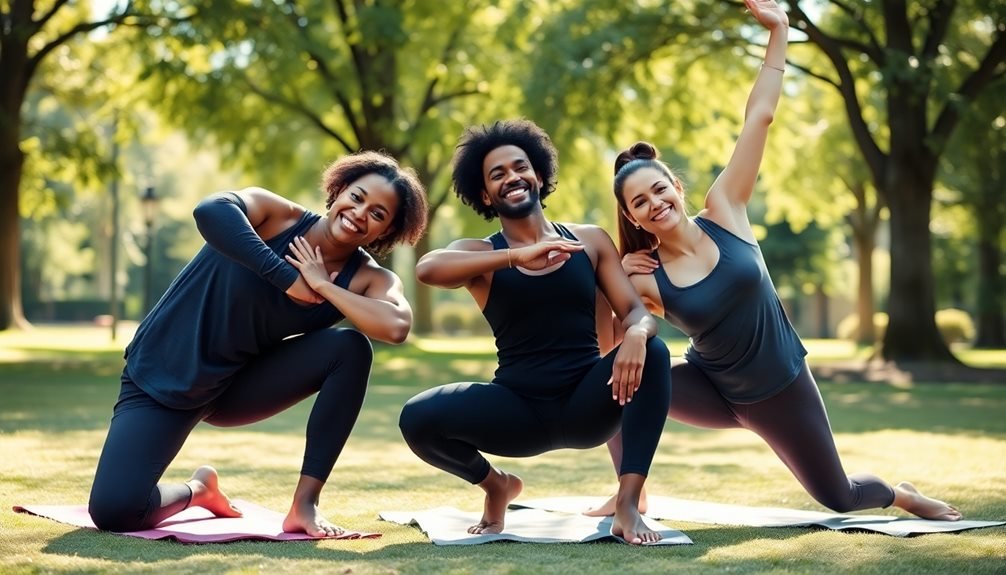
Building a reliable workout support network starts with connecting to people who share your fitness goals and understand your anxiety challenges.
You'll find these like-minded partners through anxiety-friendly fitness classes, online wellness communities, or by inviting friends who also want a low-pressure exercise environment.
Your accountability circle should include two to three trusted individuals who can check in with you regularly, celebrate your progress, and offer gentle encouragement when you're hesitant to show up for workouts.
Finding Like-Minded Workout Partners
Creating a supportive workout network starts with finding partners who share your anxiety concerns and fitness goals. Look for people who understand the mental health aspects of exercise and won't push you beyond your comfort zone. You'll find these potential partners in anxiety support groups, mental health forums, or wellness-focused social media communities.
Start your search by joining local fitness groups that specifically cater to beginners or those managing anxiety. Many gyms now offer specialized programs where you can meet others facing similar challenges. You can also use fitness apps with community features to connect with people who share your approach to exercise and mental wellness.
When reaching out to potential workout partners, be upfront about your anxiety and exercise preferences. Discuss your triggers, limitations, and the type of support you need. Choose partners who respect your boundaries and maintain a non-judgmental attitude.
It's helpful to find people who prefer low-intensity workouts, are willing to take breaks when needed, and understand that some days might be harder than others. Remember, the right workout partner will help you stay accountable while providing emotional support during challenging moments.
Building Your Accountability Circle
Once you've connected with compatible workout partners, it's time to establish a reliable support system that keeps everyone moving forward.
Create a structured accountability system that makes it easy to stay committed while managing anxiety levels. You'll find that a well-organized support network helps maintain consistency and provides emotional backup when motivation wanes.
Start by setting clear expectations with your workout partners and establish regular check-in routines. Use group messaging apps or fitness tracking platforms to share progress and encourage each other daily. Remember that accountability works best when it's positive and supportive, not punitive or pressure-filled.
- Schedule weekly progress meetings to discuss challenges and celebrate wins
- Create a shared calendar for workout times and locations
- Set up a buddy system where partners rotate responsibility for workout planning
- Establish a group chat dedicated to sharing daily wins and offering support
Focus on building trust within your circle by being reliable and consistent with your commitments.
When someone struggles with anxiety or misses a session, respond with understanding and help them strategize for next time. Your accountability circle should feel like a safe space where everyone can be honest about their challenges while working toward shared fitness goals.
Overcoming Common Group Workout Fears
Why do so many people feel anxious about joining group workouts? Common fears include feeling judged for fitness level, worrying about keeping up with others, and uncertainty about proper form or equipment use. These concerns can prevent you from experiencing the benefits of group exercise.
Start by acknowledging that most participants focus on their own workout, not on judging others. You'll find that group fitness environments often foster support rather than criticism.
If you're worried about keeping pace, choose beginner-friendly classes or inform the instructor about your experience level beforehand. They'll help modify exercises to match your abilities.
To ease equipment anxiety, arrive 10 minutes early and ask the instructor for a brief orientation. You can also watch online videos of similar classes to familiarize yourself with basic movements. Remember, everyone started as a beginner once.
If you're still hesitant, bring a friend to your first few sessions or start with smaller group classes. Virtual group workouts can also serve as a stepping stone, allowing you to build confidence from home before shifting to in-person sessions.
Frequently Asked Questions
How Soon After Starting Group Exercise Can I Expect Anxiety Relief?
You'll likely notice some immediate anxiety relief after your first session, but consistent benefits typically develop within 2-4 weeks of regular group exercise. Your body and mind need time to adapt to the routine.
Should I Tell the Instructor About My Anxiety Before Class?
Yes, you'll feel more comfortable if you inform your instructor about your anxiety. They can offer modifications, extra encouragement, and guarantee you're not put in overwhelming situations during class. It's completely normal to share this.
What if I Need to Leave Class Early Due to Anxiety?
If you're feeling anxious and need to leave, quietly let the instructor know before class starts. It's perfectly okay to step out if needed – just move near the door and exit discreetly during changes.
Are Morning or Evening Group Workout Classes Better for Anxiety Management?
Morning workouts can help you reduce anxiety throughout your day, but if you're not a morning person, evening classes work too. Choose what fits your natural rhythm and daily stress patterns best.
Can I Bring a Support Person Who Doesn't Participate in Class?
You'll need to check with your specific studio's policies. Most gyms allow observers in designated areas, but they can't enter the workout space. Contact the facility beforehand to confirm their rules.
In Summary
You've taken the first steps toward managing anxiety through group fitness, and you're not alone on this journey. Whether you choose gentle yoga, water aerobics, or walking clubs, remember that everyone starts somewhere. Start slowly, be patient with yourself, and lean on your new workout community. With consistent practice and supportive teammates, you'll build both physical strength and emotional resilience.
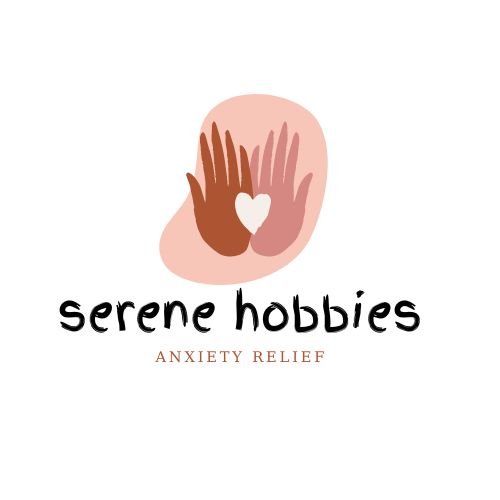
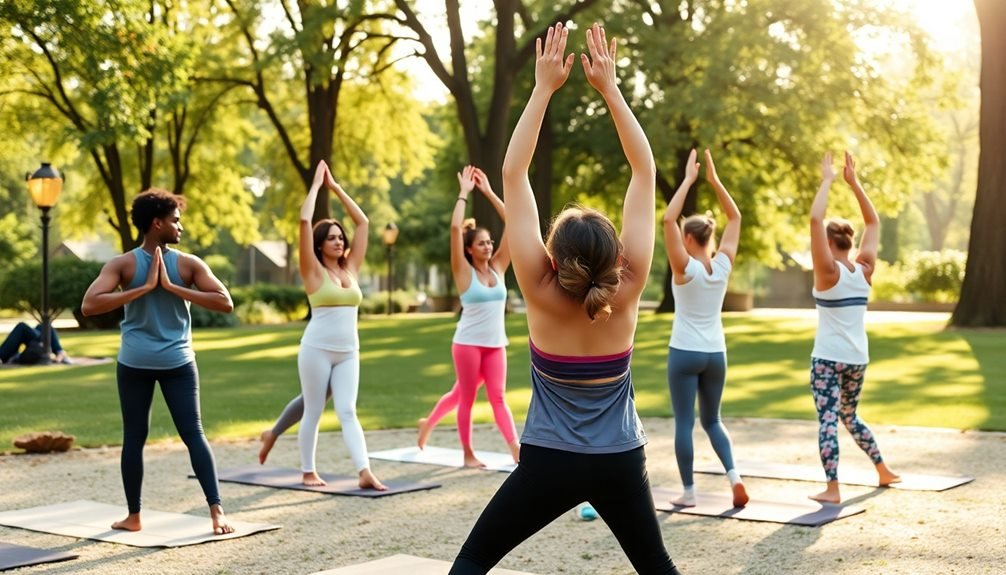
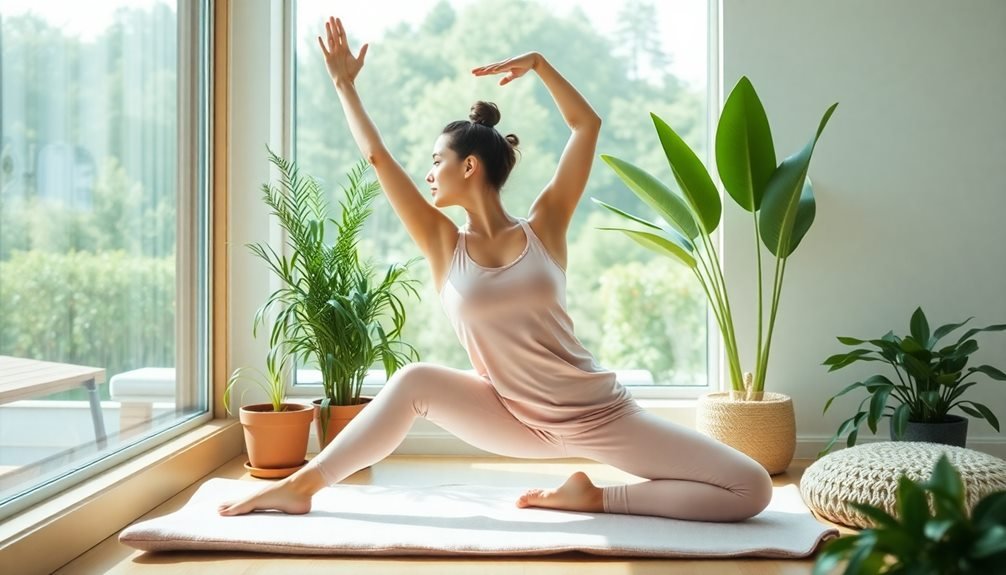
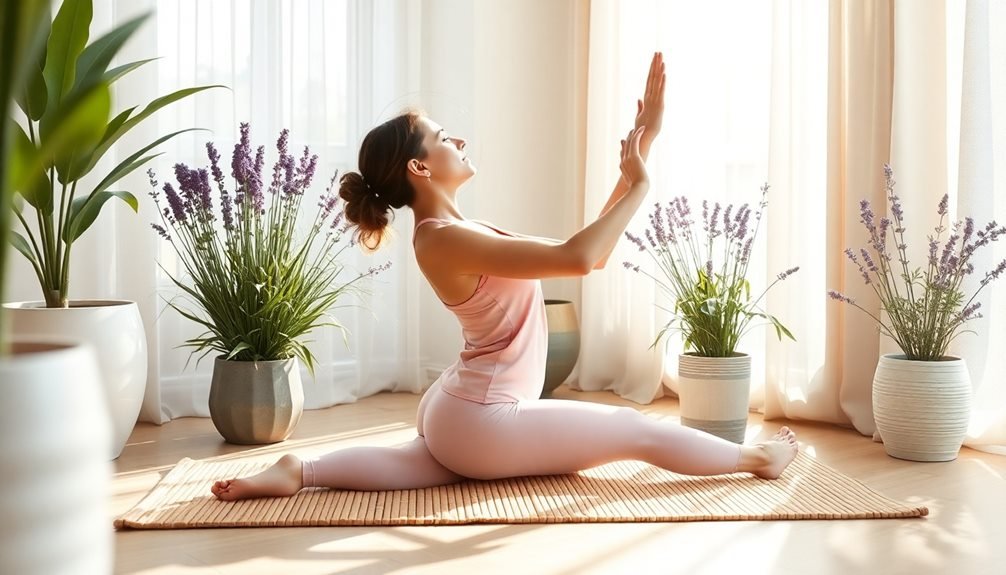
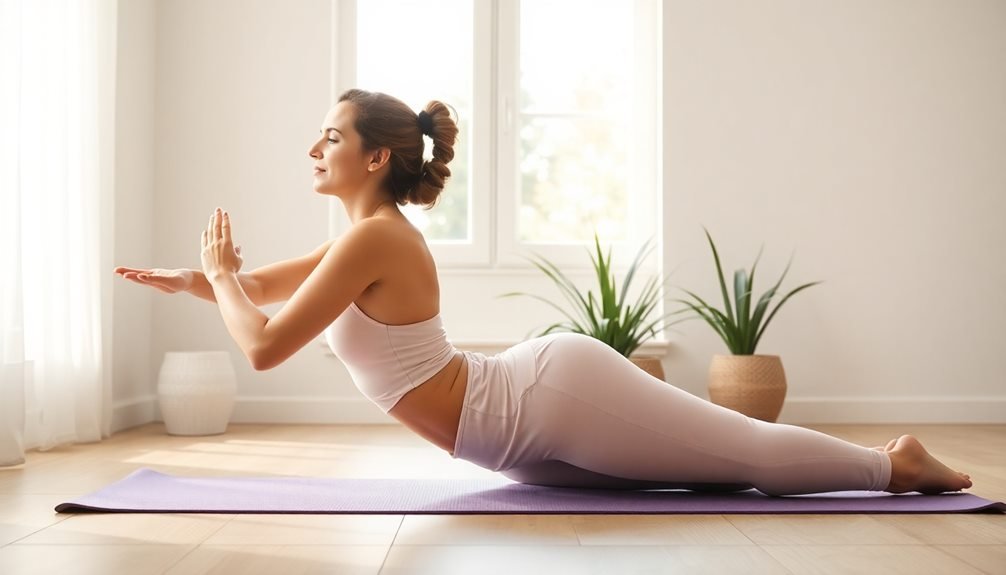
Leave a Reply